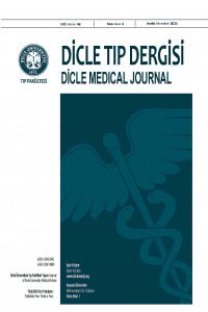Our results of mini open approach in patients with carpal tunnel syndrome
Karpal tünel, mini açık, pillar
The comparison of Brucella gel agglutination test with other Brucella tests
-,
___
- Aydin K, Cokluk C, Piksin, et al. Ultrasonographically checking the sectioning of the transverse carpal ligament during carpal tunnel surgery with limited uni skin incisions. Turk Neurosurg 2007;17:219-223.
- Kureshi SA, Friedman AH, et al. Carpal tunnel release: Surgical
- considerations. Techniq Neurosurg 2000;6:5-13.
- Okutsu I. Operative treatment for carpal tunnel syndrome. Brain Nerve 2007;59:1239-1245.
- Singer G, Ashworth CR et al. Anatomic variations and carpal
- tunnel syndrome: 10-year clinical experience. Clin Orthop Relat Res 2001;(392):330-340.
- Phalen GS. The carpal tunnel syndrome: Seventeen year- experience in diagnosis and treatment of six hundred fifty four hands. J Bone Joint Surg Am 1966;48:211-228.
- Zambelis T, Tsivgoulis G, Karandreas N, et al. Carpal tunnel syndrome: associations between risk factors and laterality. Eur Neurol 2010;63:43-47.
- Kuhlman KA, Hennessey WJ, et al. Sensitivity and specificity
- of carpal tunnel syndrome signs. Am J Phys Med Rehabil 1997;76:451-457.
- Wilson KM. Double incision open technique for carpal tunnel
- release: An alternative to endoscopic release. J Hand Surg 1994;19:907-912.
- Thomsen NOB, Cederlund R, Rosen J, et al. Clinical outcomes of surgical release among diabetic patients with carpal tunnel syndrome: prospective follow up with matched controls. J Hand Surg 2009;34:1177-1187.
- Becker J, Nora DD, Gomes I, et al. An evaluation of gender, obesity, age and diabetes mellitus as risk factors for carpal tunnel syndrome. Clin Neurophysiol 2002;113:1429-1434.
- Leit ME, Weiser RW, Tomaino MM, et al. Patient reported outcome after carpal tunnel release for advanced disease: a
- prospective and longitudinal assessment in patients older than age 70. J Hand Surg 2004;29:379-383.
- Bickel KD. Carpal tunnel syndrome. J Hand Surg Am 2010;35:147-152.
- Szabo RM. Entrapment and Compression Neuropathies. In: Green DP, Hotchkiss RN, Pederson WC (eds). Green’s Operative
- Hand Surgery. Philadelphia: Churchill Livingstone Company; 1999:1404-1422.
- ISSN: 1300-2945
- Yayın Aralığı: 4
- Başlangıç: 1963
- Yayıncı: Cahfer GÜLOĞLU
Our clinical experience on laparoscopic splenectomy: Outcomes of 38 patients
Zübeyir Bozdağ, Ahmet Türkoğlu, Bekir Taşdemir, Abdullah Oğuz, Sinan Dal, Abdullah Karakuş, Hıdır Budak, Metehan Gümüş
Assessment of mean platelet volume in type 2 diabetics receiving insulin or oral antidiabetic agents
Fatih ŞAHPAZ, Kemal Türker ULUTAŞ
Abdullah Çim, Salih Coşkun, Ahmet Yılmaz, Hüseyin Onay
Bekir TAŞDEMİR, Zeki DOSTBİL, İlhan SEZGİN
Hakan Temiz, Erdal Özbek, Serdar Toprak, Arzu Onur, Sabahattin Ertuğrul
Sebahat BAŞYİĞİT, Zeliha ASİLTÜRK, Ferdane SAPMAZ, Ayşe KEFELİ, ABDULLAH ÖZGÜR YENİOVA, METİN UZMAN, Yaşar NAZLIGÜL
Radiological screening of abdominal aortic aneurysm in individuals over 65
Hatice HABİBİ ARIÖZ, HAKKI TİMUR SİNDEL, Saim YILMAZ, MEHMET SEDAT DURMAZ, Ayşe KEVEN, Özhan ÖZGÜ
Treatment outcomes of intertrochanteric femur fractures treated with DLT™ nail
Mehmet Arıcan, Kadir Yıldız, Zekerya Karaduman, Mehmet Bulut, Serkan Özkan
Gebelikteki minör travmanın gebelik sonuçlarına etkisi var mı?
Neslihan YEREBASMAZ, Derya Cırık, Şirin AYDIN, Mualla Koçer, Fulya Kayıkçıoğlu, Leyla Mollamahmutoğlu
Hüseyin ÇİYİLTEPE, Kamuran Cumhur DEĞER, Ebubekir GÜNDEŞ, Durmuş Ali ÇETİN, ULAŞ ADAY
